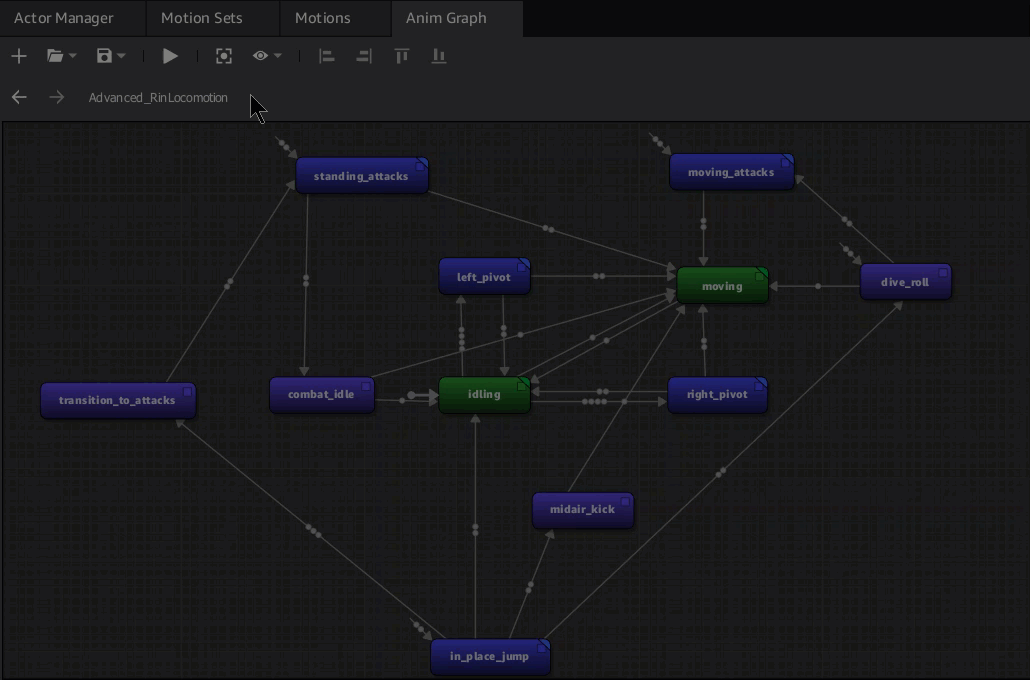IN THIS ARTICLE
O3DE UI 痕迹导航组件
使用 breadcrumbs 组件,使用户能够沿分层路径跟踪其位置。痕迹导航包括从主页到用户当前位置的路径。痕迹导航中的点是指目录或节点。用户可以通过选择其中一个痕迹导航来轻松移动路径中的位置。
有关“痕迹导航”概念的示例,请参阅 O3DE 动画编辑器中的 动画图形 导航。

在 Anim Graph 痕迹导航中,图表的名称显示为顶级导航。您打开的每个节点都显示为可单击的超链接。
面包屑小部件剖析
痕迹导航具有多个自定义选项。标准的水平布局包括以下功能:

路径历史记录导航
(可选)使用户能够在其痕迹导航路径选择的历史记录中向后和向前导航。例如,如果您浏览到列表中的新路径或选择新路径,然后选择 返回 按钮,您将导航回上一个痕迹导航位置。
面包屑路径
显示从 root 到 tail 的完整路径。用户可以选择路径中的任何点来设置新路径。以前选择的路径会自动添加到导航历史记录中。
“浏览”按钮
(可选)从技术上讲,它不是面包屑的一部分。浏览按钮通常很有用,因为它使用户能够选择全新的路径,而不是选择当前路径中的其他点。在浏览按钮处理程序代码中将新路径推送到痕迹导航小部件。
Truncation 菜单
如果整个痕迹导航路径无法容纳在分配的空间内,则路径上不适合的点将堆叠在下拉菜单中。用户可以从截断菜单中选择这些点。
基本痕迹导航

最简单的痕迹导航示例包括 breadcrumbs 小部件和一个可选的初始路径。您的代码可以通过连接到 pathChanged信号来响应路径更改。 或者,您可以调用 ‘pushPath’ 来设置痕迹导航状态以匹配项目的当前状态。
将路径 QString 传递到pushPath时,使用正斜杠 (’/’) 或反斜杠 (’\\’) 作为路径分隔符。
示例
#include <AzQtComponents/Components/Widgets/BreadCrumbs.h>
// Create a new breadcrumbs widget.
AzQtComponents::BreadCrumbs* breadCrumbs = new AzQtComponents::BreadCrumbs(parent);
// (Optional) Set the initial path.
QString initialPath = "C:/Documents/SubDirectory1/Subdirectory2/SubDirectory3";
breadCrumbs->pushPath(initialPath);
// Add the widget to a previously defined QHBoxLayout.
layout->addWidget(breadCrumbs);
// Listen for path changes.
connect(breadCrumbs, &AzQtComponents::BreadCrumbs::pathChanged, this, [](const QString& newPath) {
// Handle path change as needed by your project.
});
// Add breadcrumbs to a UI layout as needed.
带有路径导航和浏览的痕迹导航

在某些情况下,用户能够在其导航历史记录中来回导航非常有用。此外,您可能希望提供一个浏览按钮来选择新路径。
在以下示例中,createBackForwardToolBar提供向前和向后导航箭头,AzQtComponents 中的NavigationButton::Browse提供文件浏览器按钮。
示例
#include <AzQtComponents/Components/Widgets/BreadCrumbs.h>
#include <QFileDialog>
// Create a new breadcrumbs widget.
AzQtComponents::BreadCrumbs* breadCrumbs = new AzQtComponents::BreadCrumbs(parent);
// (Optional) Set the initial path.
QString initialPath = "C:/Documents/SubDirectory1/Subdirectory2/SubDirectory3";
breadCrumbs->pushPath(initialPath);
// Create the browse button widget.
auto browseButton = breadCrumbs->createButton(AzQtComponents::NavigationButton::Browse);
// Add the widgets to a previously defined QHBoxLayout.
layout->addWidget(breadCrumbs->createBackForwardToolBar());
layout->addWidget(breadCrumbs->createSeparator());
layout->addWidget(breadCrumbs);
layout->addWidget(breadCrumbs->createSeparator());
layout->addWidget(browseButton);
// Update the breadcrumb path from the output of the browse button.
connect(browseButton, &QPushButton::pressed, breadCrumbs, [breadCrumbs] {
QString newPath = QFileDialog::getExistingDirectory(breadCrumbs, "Select a new path");
if (!newPath.isEmpty())
{
breadCrumbs->pushPath(newPath);
}
});
// Listen for path changes.
connect(breadCrumbs, &AzQtComponents::BreadCrumbs::pathChanged, this, [](const QString& newPath) {
// Handle path change as needed by your project.
});
// Add the breadcrumbs to a UI layout as needed.
C++ API 参考
有关 痕迹导航 API 的详细信息,请参阅 O3DE UI 扩展 C++ API 参考 中的以下主题:
